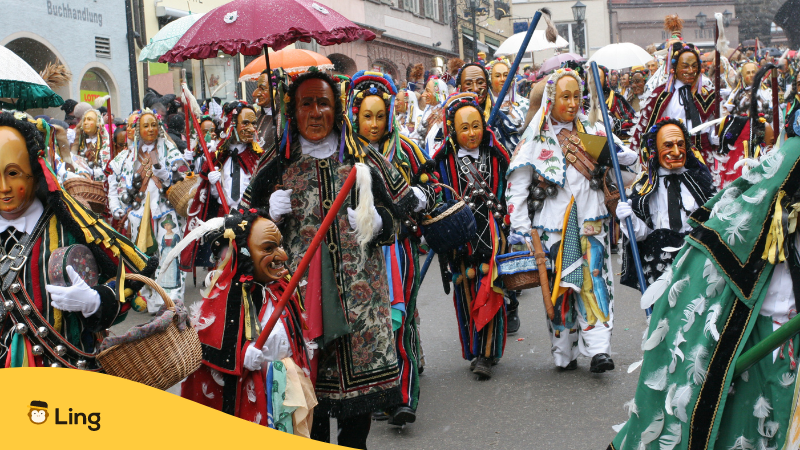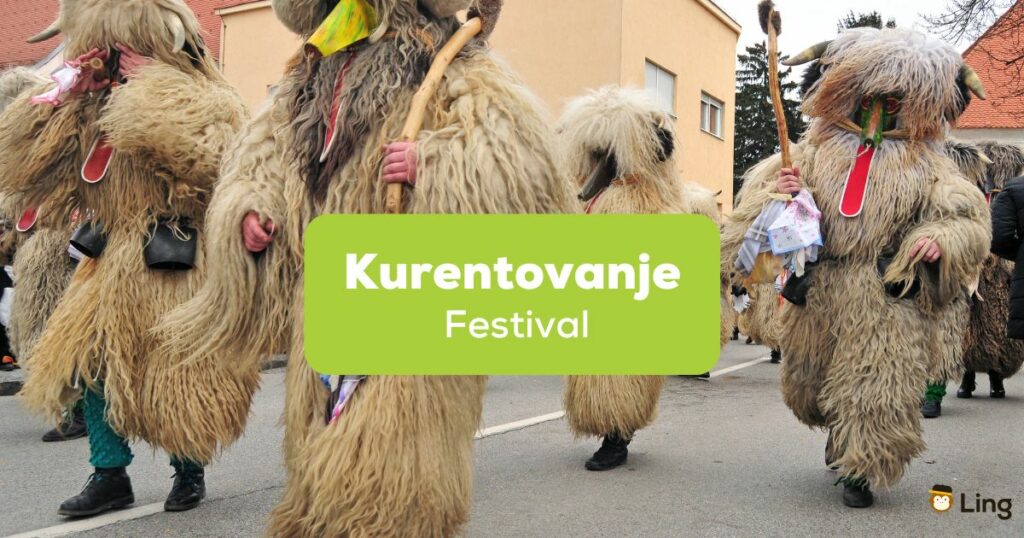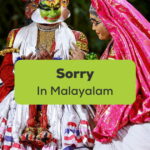Have you ever noticed that special time of year in Slovenia when both kids and grown-ups start buzzing with excitement, planning their costumes for one of the country’s most beloved annual celebrations? That’s right, I’m talking about Kurentovanje!
During this time, the country’s towns are filled with traditional carnival characters and colorful parades. But amidst all the colorful characters, there’s one that stands out: the Kurent.
Why is this figure such a significant character, and what do their mysterious shaggy costumes represent? In this blog post, we’ll answer those questions and explore this cultural tradition of Kurentovanje, which is a big part of Slovenia’s intangible cultural heritage. And if you decide to attend this fest, I’ll also cover some basic phrases you can use when beginning your journey in this small European country.

History And Origins Of Kurentovanje
Kurentovanje typically takes place each year in the period leading up to Lent, with the main event taking place on the Shrove Tuesday before Ash Wednesday. Depending on the year, it may happen in February or the beginning of March. The tradition is quite well known in the region of Ptuj and Drava fields. It dates back to the 1950s when carnival costumes, accompanied by lively music, spontaneously paraded through the main street of Ptuj, the oldest Slovenian town.
Today, Kurentovanje celebrates cultural heritage and community. Its parades, music, and parties attract over 100,000 visitors, transforming Ptuj’s historic streets into a spectacle of joy and tradition.
What Is A Kurent?
A kurent is a dress costume of a mythical character resembling a large monster-like creature. It’s traditional and has lots of symbolism, representing the wild, untamed essence of nature. The attire consists of the iconic sheepskin coat, which keeps the user warm in the cold winter, and is decorated with feathers, huge bells, chains, and horns. Furthermore, it’s said to ward off evil spirits, keep away winter, and welcome spring in hopes of a good harvest.
The kurent carries a wooden club and has a long red tongue, but even if it looks scary, it’s a good-hearted creature. According to tradition, only unmarried men used to wear the costumes; however, women and children also participate today. While the kurent costume is more or less the same across Slovenia, they can vary from region to region.

What Happens During Kurentovanje?
The celebrations consist of carnivals and parades, where people dressed in kurent costumes march through the streets of Ptuj and other Slovenian towns and villages. This is accompanied by music, dancing, and cheering crowds. The kurents like to do harmless pranks on the people in the crowd, so they sometimes playfully chase after visitors and dance around them. As someone who has experienced this, I can tell you it can be scary at first, as they are quite large! But they only mean well.
The kurents are powerful cultural symbols representing Slovenian folklore, tradition, and identity. As they run and jump down the streets, the loud bells that they carry can be heard from far away. Their presence serves as a reminder to people of the value of honoring and conserving their cultural heritage.
While the festival stands out for its unique cultural significance, also being on the UNESCO representative list, it shares similarities with other carnivals around the world, where people dressed as monsters and other creatures parade through the cities of Europe. It can be compared to the festival of Mardi Gras as well.
Parades With The Locals
Many other events take place during this time! The main parade also includes other costumed participants dressed as characters from Slovenian folklore, mythology, or history. These costumes range from elaborate traditional garments to creative and whimsical outfits that are either bought or home-made. They can also just be silly costumes inspired by favorite fictional characters! Spectators visit the parade path and are welcome to participate in the fun by cheering and engaging with the participants.
Some parades may include after-parties with costume contests to encourage people to make the best possible costumes and win prizes! These parade celebrations are referred to as ‘pustovanje,’ or simply ‘pust.’
Oh, and don’t just go marching! March with some yummy snacks in hand! Everyone’s favorite food to eat during these festivities is ‘krofi,’ which are traditional local Slovenian doughnuts. They are deep-fried and most typically filled with jam, but they can also have chocolate, custard, or other sweet fillings. They are a yummy treat for parades and carnivals, along with some hot tea.
Easy Slovenian Phrases For Kurentovanje
Do you find the festival interesting and want to blend in during the parade? Here are some easy phrases that you can use to have a conversation with your Slovenian friends:
| English | Slovenian |
|---|---|
| You have such a nice costume! | Kako lep kostum imaš! |
| How long do the carnival festivities last? | Kako dolgo traja pustovanje? |
| Who has the most original costume? | Kdo ima najbolj izviren kostum? |
| Have you tried krofi yet?’ | Si že poskusil/a krofe? |
| Kurent scares the winter away. | Kurent preganja zimo. |
| The kurent’s costume has cow bells. | Kurentov kostum ima kravje zvonce. |
| Are you scared of the kurent mask? | Se bojiš kurentove maske? |
Learn Slovenian With Ling!
While you’re enjoying the costume parties and running away from the kurents, you might want to immerse yourself into the culture even further. In that case, consider adding the Ling app to your everyday routine. It could help you greatly with learning the Slovenian language!
Ling’s lesson plans will teach you Slovenian vocabulary, grammar, and even allow you to practice conversations with a chatbot. Just picture yourself wandering around the streets of Ptuj during carnival season, talking with people like a local!
So go ahead and download the Ling app from the App Store or Google Play, and start your language journey today.


































































